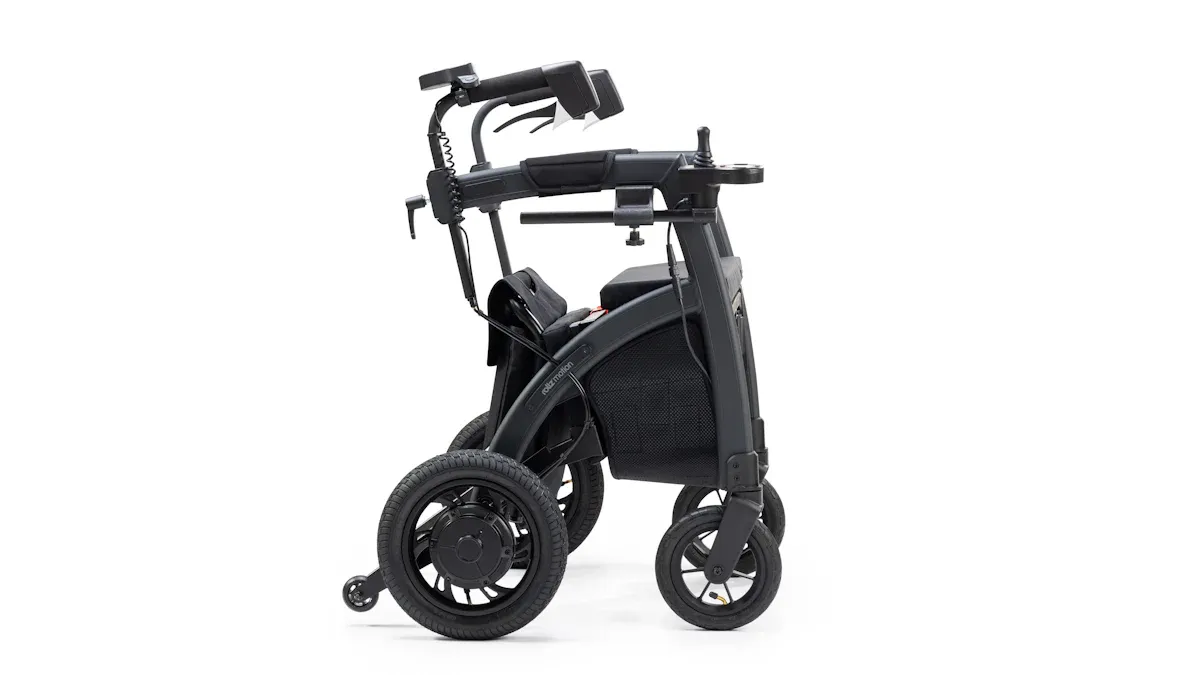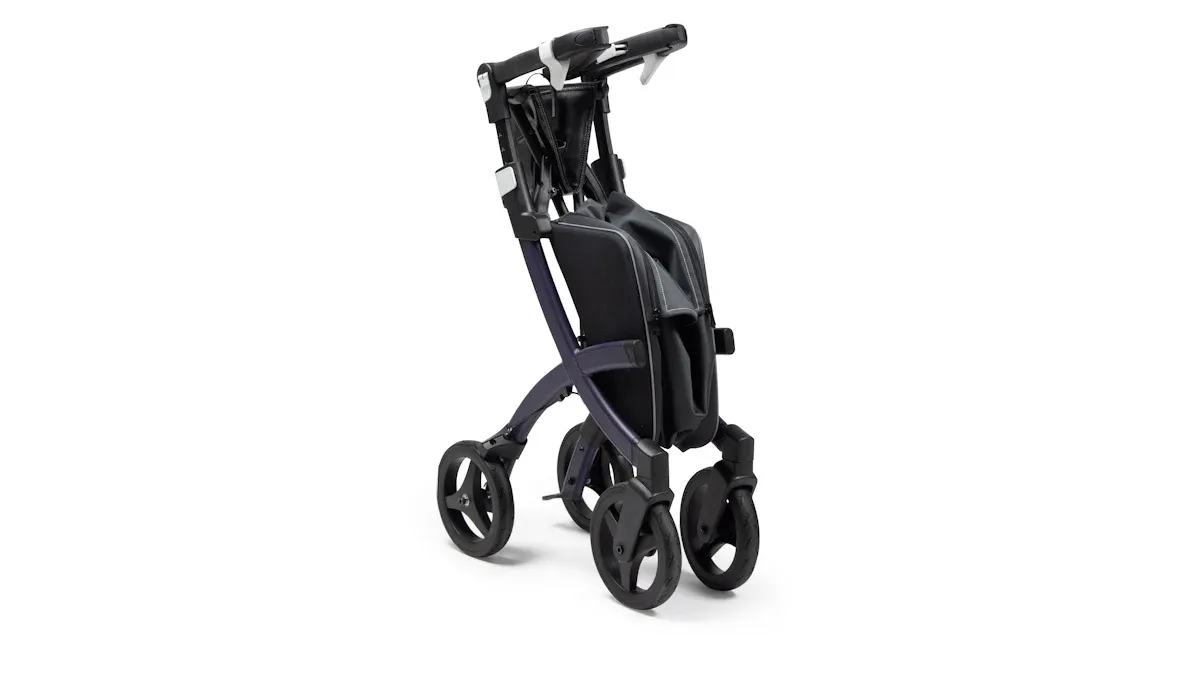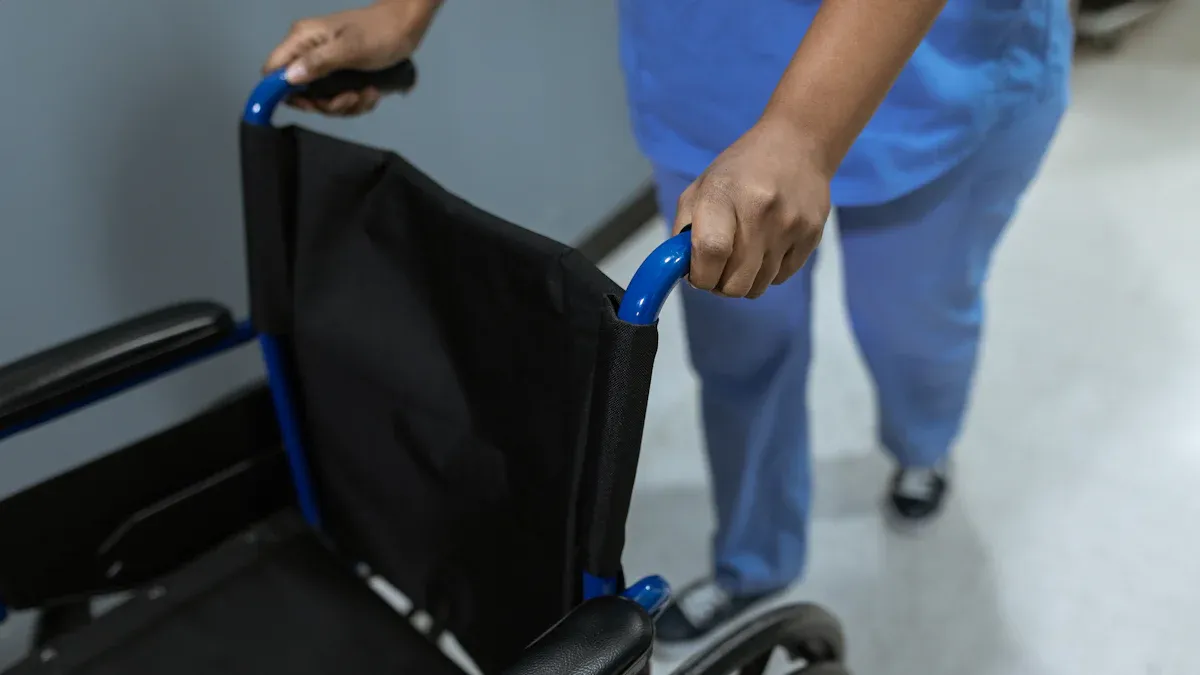
Taking care of a foldable wheelchair is essential to keep users safe and mobile. Many people using a motorized wheelchair report an average of 2.86 part failures, with 57% experiencing breakdowns within just three months. Regular maintenance is crucial for extending the lifespan of both an electric power wheelchair and a power chair. Here’s how proper care can make a significant difference:
| Issue | Percentage/Value |
|---|---|
| Users with breakdowns (3 months) | 57% |
| Average part failures | 2.86 |
Key Takeaways
- Regular cleaning and daily safety checks keep your foldable wheelchair safe, comfortable, and reliable.
- Follow a simple schedule for inspecting brakes, tires, folding parts, and upholstery to prevent breakdowns and extend wheelchair life.
- Seek professional help for serious damage or electrical issues to ensure safety and maintain top performance.
Daily and Weekly Foldable Wheelchair Maintenance

Quick Cleaning and Hygiene
Keeping a foldable wheelchair clean helps prevent dirt buildup and keeps it looking good. Wipe down the frame, seat, and armrests with a damp cloth every day. Use mild soap and water for sticky spots. Dry all surfaces to stop rust and mold. Pay attention to areas where hands touch often. Clean these spots to reduce germs and keep the wheelchair safe for daily use.
Tip: Carry a small cleaning kit with wipes and a soft cloth. This makes it easy to clean up spills or dirt on the go.
Brake Function and Safety Check
Brakes keep the user safe. Test the brakes every day before using the foldable wheelchair. Push the wheelchair gently and apply the brakes. The wheels should stop right away. If the brakes feel loose or do not hold, adjust them or ask for help. Never use a wheelchair with faulty brakes.
Tire and Caster Inspection
Tires and casters help the wheelchair move smoothly. Check them for cracks, flat spots, or anything stuck in the treads. Spin the casters to make sure they turn freely. Remove any hair or debris wrapped around them. If a tire looks worn or flat, plan to replace it soon.
| What to Check | How Often | What to Look For |
|---|---|---|
| Tires | Daily | Cracks, flats, debris |
| Casters | Daily | Smooth spin, no noise |
Folding Mechanism Test
A foldable wheelchair needs a working folding mechanism. Open and close the wheelchair a few times each week. Listen for squeaks or grinding sounds. Make sure the frame locks in place when unfolded. If folding feels stiff, check for dirt or rust. Clean and dry the joints as needed.
Upholstery and Cushion Care
Upholstery and cushions give comfort and support. Brush off crumbs and dust every day. Wipe the fabric with a damp cloth once a week. Let cushions air out to prevent odors. If the cover is removable, wash it as directed by the manufacturer. Check for rips or worn spots and fix them quickly.
Footrest, Armrest, and Anti-Tip Device Check
Footrests and armrests help with comfort and safety. Make sure they are tight and not wobbly. Test the anti-tip devices to see if they are secure. If anything feels loose, tighten the screws or bolts. Replace broken parts right away to avoid accidents.
Note: A quick check of these parts each week can prevent bigger problems later.
Monthly Foldable Wheelchair Maintenance
Deep Cleaning and Detailing
Once a month, users should give their foldable wheelchair a deep clean. They can use a soft brush to remove dust from hard-to-reach spots. Warm water and mild soap work well for cleaning the frame and wheels. After washing, they should dry every part with a towel. This step helps stop rust and keeps the wheelchair looking new.
Tip: Pay extra attention to the spaces between joints and under the seat. Dirt often hides in these areas.
Lubricating Moving Parts
Moving parts need oil to work smoothly. Users should apply a small amount of lubricant to hinges, folding joints, and wheel axles. They should wipe away any extra oil to avoid sticky buildup. Lubrication helps the folding mechanism and wheels move without squeaks or stiffness.
Frame, Joint, and Bolt Inspection
A monthly check of the frame, joints, and bolts keeps the wheelchair safe. Users should look for cracks, bends, or loose bolts. They can use a wrench to tighten any loose parts. If they find damage, they should contact a repair shop.
Tire Pressure and Wheel Alignment
Proper tire pressure makes the ride smoother. Users should check the tires with a pressure gauge. They can add air if the tires feel soft. For wheel alignment, they should roll the wheelchair on a flat surface and see if it moves straight. If it pulls to one side, a technician may need to adjust it.
Caster Bearing Cleaning
Caster bearings collect dust and hair. Users should remove the casters if possible and clean the bearings with a dry cloth. Clean bearings help the wheelchair turn easily and prevent wear.
Quarterly and Annual Foldable Wheelchair Maintenance
Detailed Frame and Structural Check
A foldable wheelchair works best when its frame stays strong. Every few months, users should look closely at the cross-brace, joints, and main frame. They need to check for cracks, bends, or rust. Problems with the cross-brace can cause the wheelchair to collapse. Regular checks help prevent injuries and keep the wheelchair safe. Here are some long-term benefits of detailed checks and professional servicing:
- Saves money on repairs by catching problems early
- Extends the life of the wheelchair
- Prevents injuries and long-term damage to users
- Reduces the risk of collapse from hidden frame issues
- Keeps suspension and frame parts working well
Users who keep up with maintenance are much less likely to get hurt. Research shows they are 10 times less likely to have an injury than those who skip checks.
Tightening Bolts and Screws
Loose bolts and screws can make a wheelchair rattle or feel unstable. Every few months, users should inspect all bolts and screws. They should tighten them until snug, but not too tight. Damaged bolts need replacing right away. This simple step keeps all parts secure and working together.
| Maintenance Task | Frequency | Key Points |
|---|---|---|
| Tightening Nuts and Bolts | Monthly/Quarterly | Check for looseness; tighten snugly; replace damaged bolts; prevent rattling |
Battery and Electrical System Check (for Electric Models)
Electric wheelchairs need extra care. Users should inspect the battery charger and cables every few months. They should use the original charger and look for frayed wires or corrosion. All connectors must fit firmly. Keeping the electrical system in good shape prevents charging problems and keeps the wheelchair running smoothly.
| Maintenance Task | Frequency | Key Points |
|---|---|---|
| Battery Charger Inspection | Monthly/Quarterly | Use original charger; check cables; supports battery health |
| Electrical Connections and Cables | Monthly/Quarterly | Inspect for corrosion; ensure safe routing; prevents failures |
Professional Servicing and Tuning
A professional service visit gives a foldable wheelchair a full checkup. Experts can spot hidden problems and tune up the wheelchair for top performance. Most users should schedule a service at least once a year. In areas with harsh weather, twice a year is even better. Professional care supports safety, comfort, and long-term use.
If a user’s weight changes a lot, a professional should check the frame and suspension soon after.
Special Tips for Manual and Electric Foldable Wheelchairs

Manual Wheelchair Care
Manual wheelchairs have a simple design, so their upkeep is pretty straightforward. Most users can handle the basics at home. Here are some important steps for keeping a manual foldable wheelchair in top shape:
- Inspect and tighten loose screws and bolts often.
- Lubricate moving parts to keep everything running smoothly.
- Wipe down the frame each week with a damp cloth.
- Remove and wash seat cushion covers for a deeper clean.
- Check tires for wear and make sure the brakes work well.
- Every few months, do a deep clean and look for any frame damage.
Regular care helps a manual wheelchair last longer and stay safe. Most users find these tasks easy to remember and quick to do.
Electric Wheelchair Care
Electric wheelchairs need a bit more attention. They have batteries, motors, and extra wiring, which means more things can go wrong. Users should charge the battery after each use and check the charger and cables for damage. Cleaning the frame and seat is still important, but they also need to watch for signs of electrical trouble.
The table below shows how manual and electric foldable wheelchairs compare when it comes to upkeep:
| Aspect | Manual Foldable Wheelchair | Electric (Power) Foldable Wheelchair |
|---|---|---|
| Maintenance Tasks | Basic cleaning, tightening, tire checks | Battery charging, motor and electrical checks |
| Cost of Upkeep | Lower | Higher |
| Portability | Lighter, easy to fold | Bulkier, harder to move |
| Reliability Concerns | Few, no electric parts | Battery and charging are key |
Electric models keep users moving, but they need regular battery care and more frequent check-ups. A little extra attention goes a long way.
When to Seek Professional Help for Your Foldable Wheelchair
Signs of Serious Wear or Damage
Sometimes, a wheelchair needs more than a quick fix at home. If someone sees cracks, bends, or broken welds on the frame, it is time to call a professional. Large rips or sagging in the seat or backrest also mean the chair is not safe. Brakes that do not hold or wheels that wobble can cause accidents. Experts say that catching these problems early can help prevent bigger repairs and keep users safe.
Tip: If a wheelchair makes new noises or feels different, do not ignore it. Small changes can signal bigger problems.
Issues with Folding or Stability
A foldable wheelchair should open and close smoothly. If it gets stuck, feels stiff, or will not lock in place, a technician should check it. Problems with folding can point to hidden damage in the joints or cross-brace. Stability issues, like the chair tipping or feeling shaky, are also warning signs. Experts recommend annual professional inspections to catch these issues before they get worse.
Here are some common problems that need expert help:
- Frame damage (cracks, bends)
- Brake failure
- Wobbly wheels or broken spokes
- Grinding or stuck bearings
Electrical or Battery Problems
Electric wheelchairs have extra parts that need special care. If the battery leaks, swells, or will not hold a charge, a certified technician should look at it. Error codes, unresponsive controls, or strange motor noises also need expert attention. Only trained professionals with RESNA certification or manufacturer approval should repair electrical systems. Using the right expert keeps the wheelchair safe and working well.
| Category | Examples/Details |
|---|---|
| Types of Issues | Frame cracks, brake failure, wheel problems, power chair malfunctions, battery issues, upholstery damage |
| Technician Qualifications | RESNA-certified, manufacturer-recommended, found in RESNA directory |
| Maintenance Frequency | Annual inspections, routine checks, early problem detection |
Keeping Records and Following Manufacturer Guidance for Foldable Wheelchairs
Maintenance Log
A maintenance log helps users remember what work they have done on their wheelchair. They can write down each cleaning, inspection, or repair. This record shows when they last checked the brakes or cleaned the casters. If a problem comes up, the log helps a technician see what has already been fixed.
Many people use a simple notebook or a digital app for this. Here is an example of what a maintenance log might look like:
| Date | Task Completed | Notes |
|---|---|---|
| 04/01/2024 | Cleaned wheels | Removed hair |
| 04/15/2024 | Checked brakes | Working well |
| 05/01/2024 | Tightened bolts | No issues found |
Tip: Keeping a log makes it easier to spot patterns or repeated problems.
Using the Owner’s Manual
The owner’s manual gives important details about the wheelchair. It explains how to fold, clean, and adjust the chair. Users can find the right way to care for their model. The manual also lists warning signs that mean it is time to call a professional.
If someone loses the manual, they can often find a copy online. Reading the manual helps users avoid mistakes and keeps the wheelchair safe. The manual also lists the best cleaning products and tools for each part.
Note: Always follow the manufacturer’s advice for repairs and cleaning. This keeps the warranty valid and the wheelchair in good shape.
- Regular care helps a foldable wheelchair stay safe and comfortable.
- A simple cleaning and inspection schedule makes upkeep easy.
- The owner’s manual gives helpful tips for each model.
- When repairs seem tough, they should call a professional for help.
FAQ
How often should someone clean a foldable wheelchair?
Most people clean their wheelchair every week. Quick wipe-downs each day help keep it fresh and safe. Deep cleaning once a month works best.
What should a user do if the wheelchair feels hard to fold?
They should check for dirt or rust in the joints. A little lubricant can help. If folding still feels tough, a technician can take a look.
Can a user use household cleaners on wheelchair parts?
Mild soap and water work well for most parts. Strong chemicals might damage the frame or fabric. Always check the owner’s manual for safe cleaning tips.
Post time: Jun-19-2025
